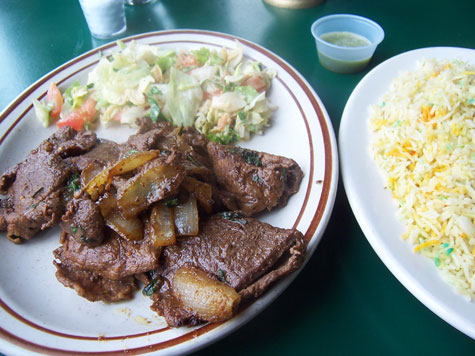
WITH PERFECT RICE Fez’s garlicky beefsteak. |
On one wall of Fez restaurant is a portrait of the African continent. And there are some indications that Fez is in fact pan-African in approach. The eponymous headgear is most popular in the northern part of Africa, and the exterior sign advertises "Mediterranean Cuisine," of the sort you might find north of the Sahara. While the menu includes some north African dishes, there are also a number from the eastern shore nations of Ethiopia and Somalia. The bright orange walls feature a mural depicting the sort of African tundra and wildlife one associates with Kenya and parts south.
Upon closer inspection, however, two nations have been drawn into the continent to the exclusion of all the others: Somalia and Djibouti. This is a telling indication of where Fez's strength and emphasis really lies. The menu at Fez, which seems to have been recently reworked, is still finding its place. Eventually that place will most likely be around Somalia. This is more than fine, since Somali cuisine is among the world's most varied and appealing. Thanks to its location along coastal trade routes, Somali food incorporates influences from as far afield as Italy (including many pastas) and India. Portland has mostly lacked for Somali restaurants, despite the number of immigrants who have settled here. So if Fez eventually flourishes as a Somali place, all the better.
In its current form, Fez offers some scrappy appeal. The menu features dishes with quirky names like "salmon fashion" and "chicken fantastic." The servers, in lovely bright-colored hijab, are charming. The woman who runs the place smiles warmly, unselfconsciously calls customers "honey," and touches your shoulder upon receiving compliments. If it's not busy, she might surprise you with a free Vimto cordial, served with a slice of fresh peach.
We found a good bit to compliment in the dishes we tried. A sampler of appetizers featured two crisp sambusa filled with ground beef seasoned with plenty of herbs. They were especially good when dabbed with a thin green sauce that managed to be minty, sour, and hot all at once. Big balls of quite spicy falafel went nicely with the soothing cool of a creamy, lemony hummus.
An entrée of goat meat roasted on the bone made few concessions to the American palate. The Somali spices were earthy and slightly bitter, which complemented the dark flavor of the lean meat. It was served in a simple style with grilled onions and tomato over rice. That rice was perhaps better appreciated when served on its own platter next to a big dish of thin beefsteak grilled with a delicious garlicky sauce. The rice was perfectly done — light yet toothsome, and infused with saffron and turmeric, with grains all varieties of white, yellow, orange, and even blue-green.
Perhaps the most appealing blend of spices we found was in a chicken dish served with anjeera — the thin spongy pancake associated with Ethiopia and Eritrea. Tender pieces of white meat were stewed in an addictive sauce that mingled herbs, tomato, and perhaps some sour tamarind. We tried several sandwiches (at $4.99 a very reasonable lunch) — a darkly grilled and salty beef shwarma, and a chicken suqaar with cubes of meat cooked in a blend of spices a bit like Indian tandoor. Each was served wrapped in a pita with lettuce and tomato.